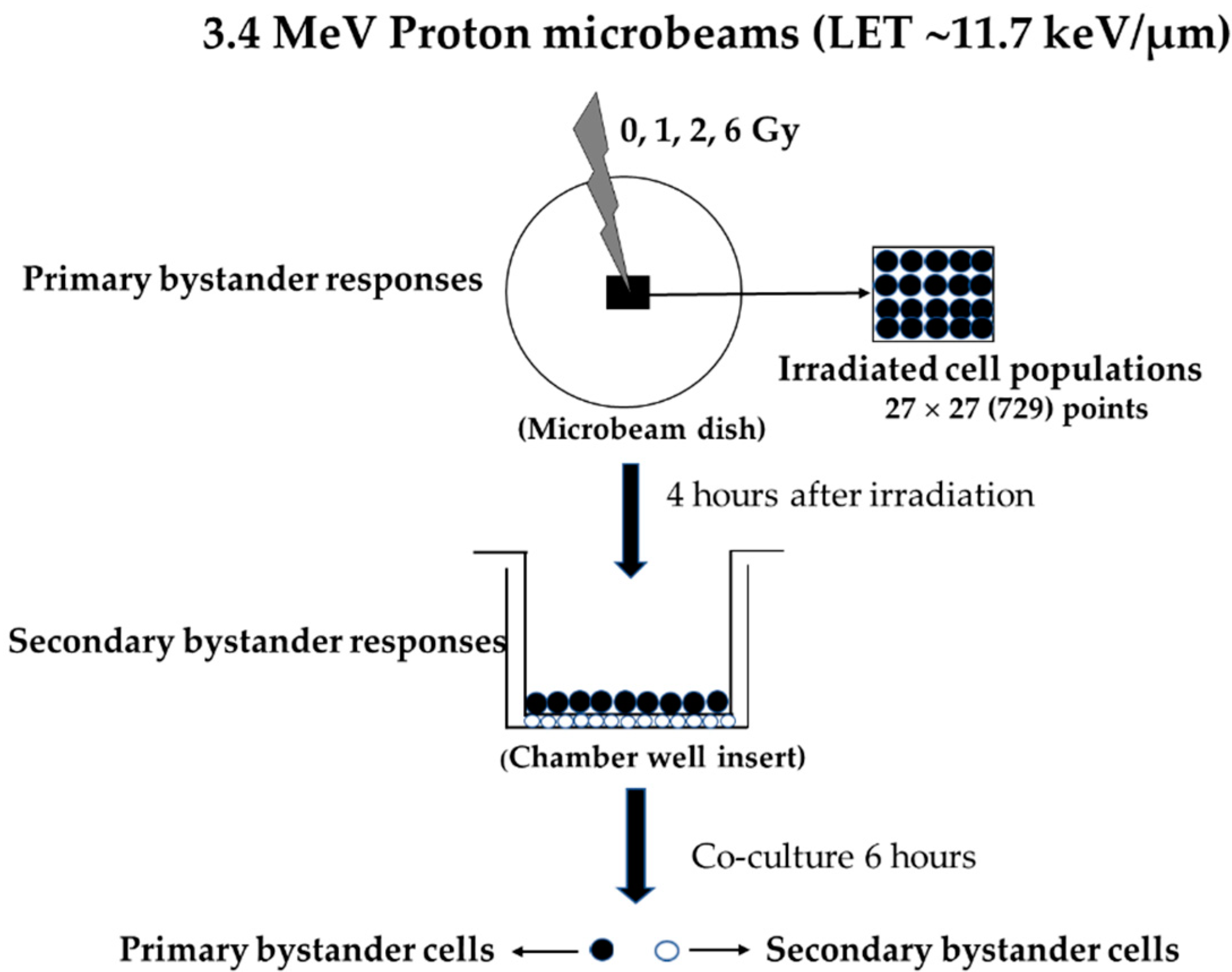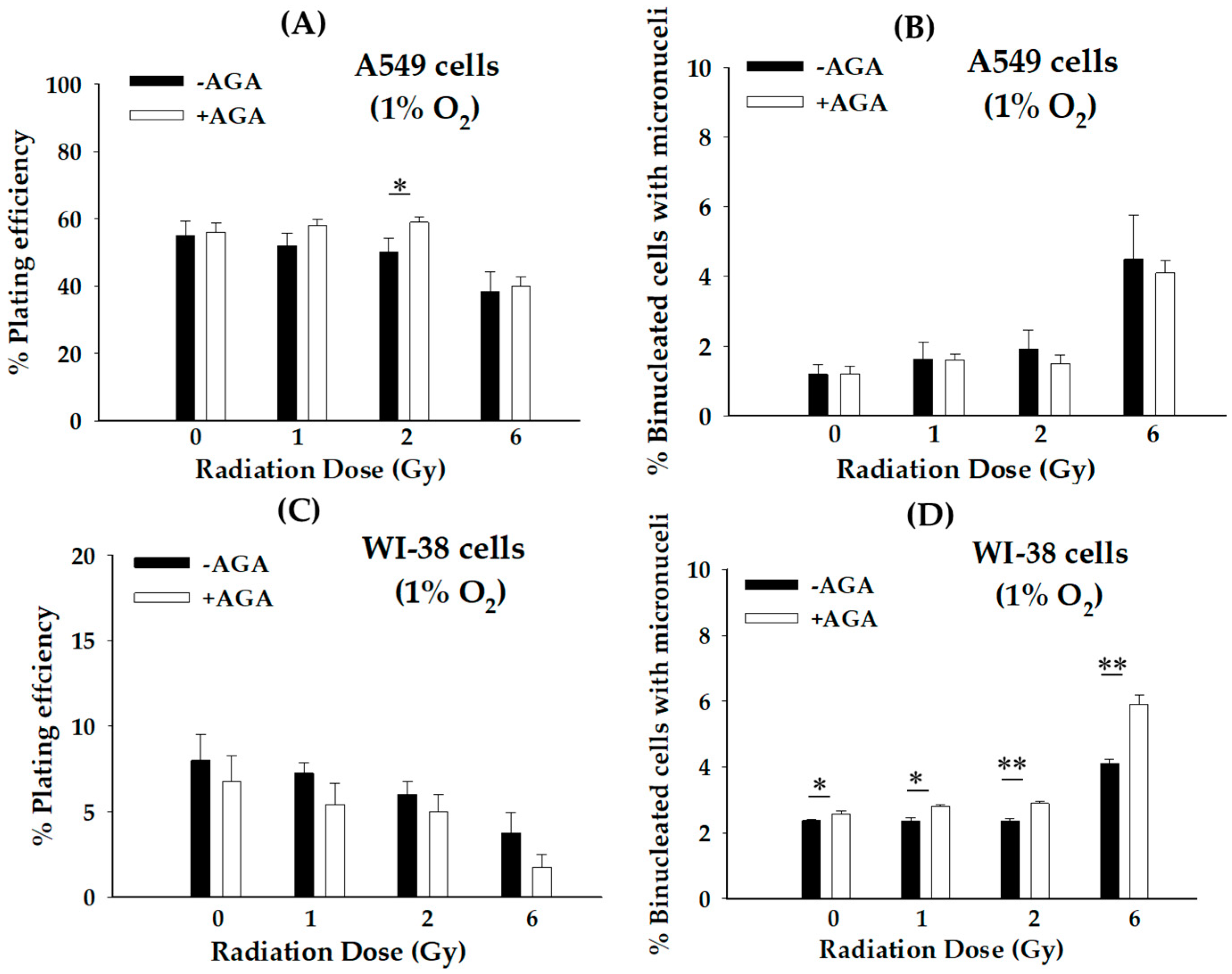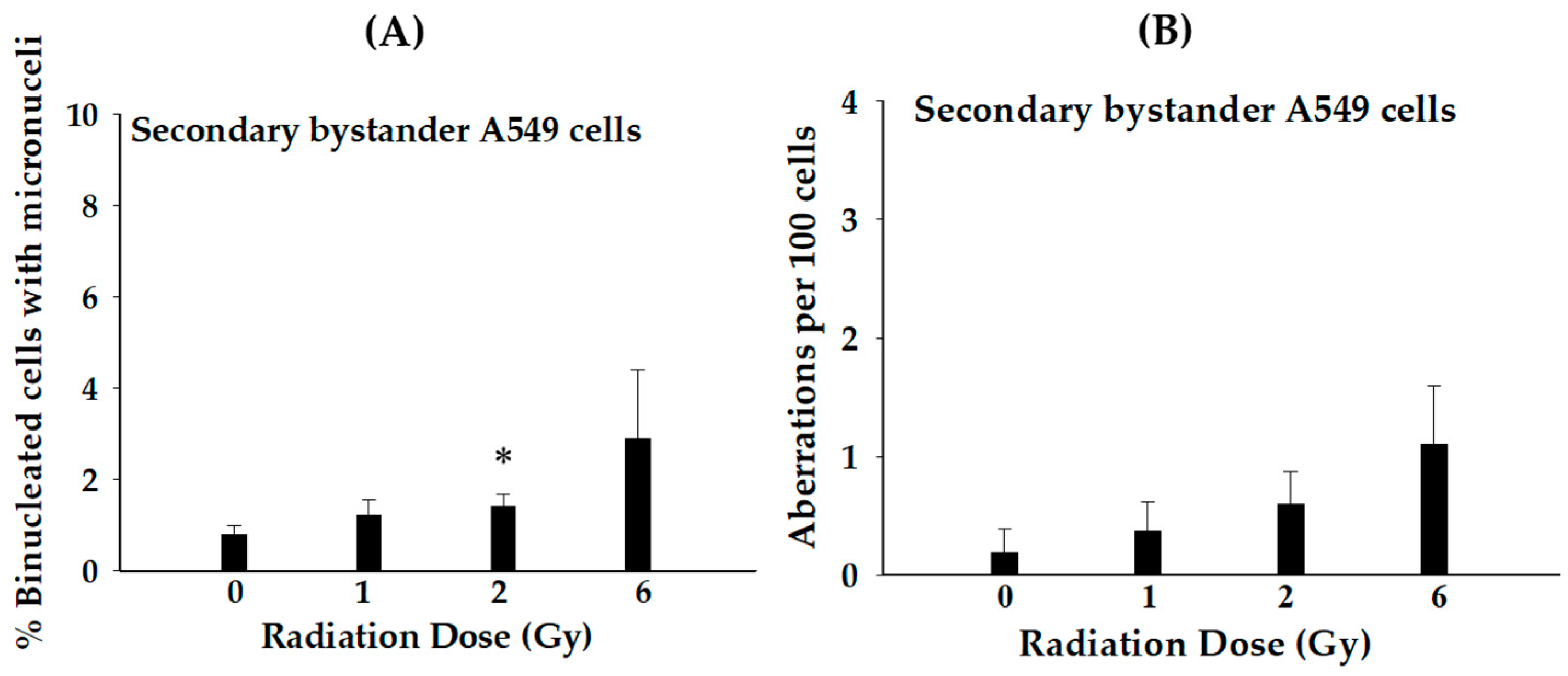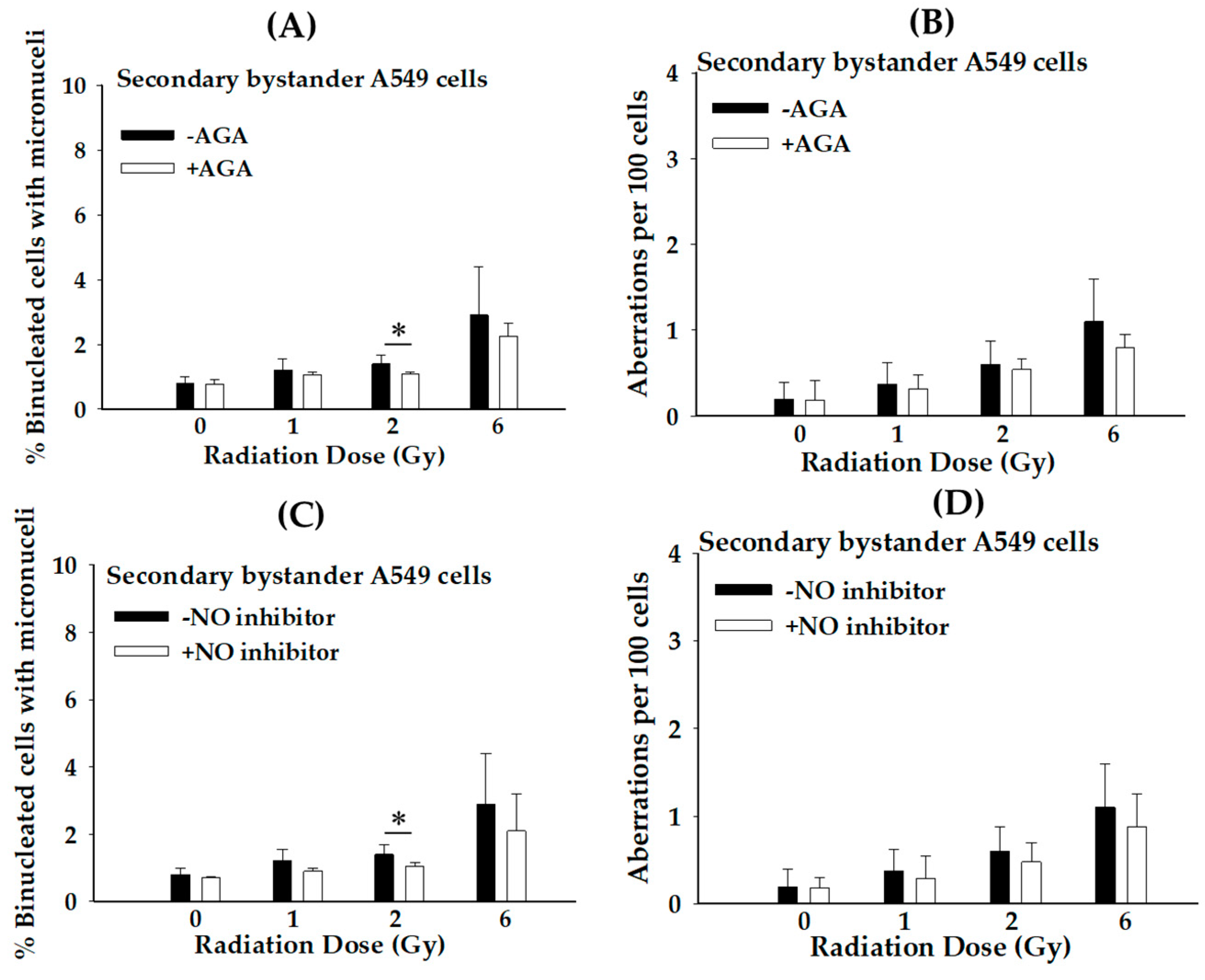Primary and Secondary Bystander Effects of Proton Microbeam Irradiation on Human Lung Cancer Cells under Hypoxic Conditions
Abstract
:Simple Summary
Abstract
1. Introduction
2. Materials and Methods
2.1. Cell Culture
2.2. Sample Preparation and Proton Microbeam Irradiation
2.3. Co-Culture System to Elucidate Radiation-Induced Secondary Bystander Effect
2.4. Clonogenic Survival Assay
2.5. Micronucleus Formation Assay
2.6. Chromosome Aberration Assay
2.7. Inhibition of GJIC
2.8. Nitric Oxide (NO) Scavenger
2.9. Statistical Analysis
3. Results
3.1. RIBE in Primary Bystander Normal and Cancer Cells Exposed to Proton Microbeam under Hypoxic and Normoxic Conditions
3.2. Role of GJIC in Propagation of Stressful or Protective Effects in Primary Bystander Normal and Cancer Cells following Proton Microbeam Irradiation under Hypoxic and Normoxic Conditions
3.3. RISBE in Secondary Bystander Cancer Cells Exposed to Proton Microbeam Irradiation under Hypoxic Conditions
3.4. Roles of GJIC and Secreted Diffusible Factors in Propagation of Stressful Effect in Secondary Bystander Cancer Cells Exposed to Proton Microbeam Irradiation under Hypoxic Conditions
4. Discussion
5. Conclusions
Author Contributions
Funding
Institutional Review Board Statement
Informed Consent Statement
Data Availability Statement
Acknowledgments
Conflicts of Interest
References
- Durante, M.; Loeffer, J.S. Charged particle in radiation oncology. Nat. Rev. Clin. Oncol. 2010, 7, 37–43. [Google Scholar] [CrossRef]
- Konishi, T.; Oikawa, M.; Suya, N.; Ishikawa, T.; Maeda, T.; Kobayashi, A.; Shiomi, N.; Kodama, K.; Hamano, T.; Homma-Takeda, S.; et al. SPICE-NIRS microbeam: A focused vertical system for proton irradiation of a single cell for radiobiological research. J. Radiat. Res. 2013, 54, 736–747. [Google Scholar] [CrossRef]
- Autsavapromporn, N.; Kobayashi, A.; Liu, C.; Jaikang, C.; Tengku Ahmad, T.A.; Oikawa, M.; Konishi, T. Hypoxia and proton microbeam: Role of gap junction intercellular communication in inducing bystander responses on human lung cancer cells and normal Cells. Radiat. Res. 2022, 197, 122–130. [Google Scholar] [CrossRef]
- Choi, V.W.Y.; Yum, E.H.W.; Konishi, T.; Oikawa, M.; Cheng, S.H.; Yu, K.N. Triphasic low-dose response in zebrafish embryos irradiated by microbeam protons. J. Radiat. Res. 2012, 53, 475–481. [Google Scholar] [CrossRef]
- Yokota, Y.; Funayama, T.; Kobayashi, A.; Mutou-Yoshihara, Y.; Ikeda, H.A.; Kobayashi, Y. The bystander cell-killing effect mediated by nitric oxide in normal human fibroblasts varies with irradiation dose but not with radiation quality. Int. J. Radiat. Biol. 2015, 91, 383–388. [Google Scholar] [CrossRef]
- Nagasawa, H.; Little, J.B. Induction of sister chromatid exchanges by extremely low doses of alpha-particles. Cancer Res. 1992, 52, 6394–6396. [Google Scholar]
- Dong, C.; He, M.; Tu, W.; Konishi, T.; Liu, W.; Xie, Y.; Dang, B.; Li, W.; Uchihori, Y.; Hei, T.K.; et al. The differential role of human macrophage in triggering secondary bystander effects after either gamma-ray or carbon beam irradiation. Cancer Lett. 2015, 363, 92–100. [Google Scholar] [CrossRef]
- Buonanno, M.; Gonon, G.; Pandey, B.N.; Azzam, E.I. The intercellular communications mediating radiation-induced bystander effects and their relevance to environmental, occupational and therapeutic exposures. Int. J. Radiat. Biol. 2023, 99, 964–982. [Google Scholar] [CrossRef]
- Harada, K.; Nonaka, T.; Hamada, N.; Sakurai, H.; Hasegawa, M.; Funayama, T.; Kakizaki, T.; Kobayashi, Y.; Nakano, T. Heavy-ion-induced bystander killing of human lung cancer cells: Role of gap junctional intercellular communication. Cancer Sci. 2009, 100, 684–688. [Google Scholar] [CrossRef]
- Tomita, M.; Torigata, C.M.; Ohchi, T.; Ito, A. Observation of histone H2AX phosphorylation by radiation-induced bystander response using titanium characteristic X-ray microbeam. Biology 2023, 12, 734. [Google Scholar] [CrossRef]
- Hei, T.K.; Zhou, H.; Ivanov, V.N.; Hong, M.; Lieberman, H.B.; Brenner, D.J.; Amundson, S.A.; Geard, C.R. Mechanism of radiation induced bystander effects: A unifying model. J. Pharm. Pharmacol. 2008, 60, 943–950. [Google Scholar] [CrossRef]
- Prise, K.M.; Belyakov, O.V.; Folkard, M.; Michael, B.D. Studies of bystander effects in human fibroblasts using a charged particle microbeam. Int. J. Radiat. Biol. 1998, 74, 793–798. [Google Scholar] [CrossRef]
- Homplaned, T.; Fjeldbo, C.S.; Lyang, H. Tumor hypoxia as a barrier in cancer therapy: Why levels matter. Cancers 2021, 13, 499. [Google Scholar] [CrossRef]
- Chan, C.C.; Chen, F.H.; Haiso, Y.Y. Impact of hypoxia on relative biological effectiveness and oxygen enhancement ratio for a 62-MeV therapeutic proton beam. Cancers 2021, 13, 2997. [Google Scholar] [CrossRef]
- Tinganelli, W.; Durante, M.; Hirayama, R.; Krämer, M.; Maier, A.; Kraft-Weyrather, W.; Furusawa, Y.; Fieldrich, T.; Scifoni, E. Kill-painting of hypoxic tumours in charged particles therapy. Sci. Rep. 2015, 5, 17016. [Google Scholar] [CrossRef]
- French, M.; Moeley, A.A. Cytokinesis-block micronucleus method in human lymphocytes: Effect of in vivo aging and low-dose x-irradiation. Mutat. Res. 1986, 161, 193–198. [Google Scholar]
- Ortiz, R.; Belshi, R.; Marzi, L.D.; Prezado, Y. Proton minibeam radiation therapy for treating metastases: A treatment plan study. Med. Phys. 2022, 50, 2463–2473. [Google Scholar] [CrossRef]
- Chen, X.; Wang, P.; Guo, F.; Wang, X.; Wang, J.; Xu, J.; Yuan, D.; Zhang, J.; Shao, C. Autophagy enhanced the radioresistance of non-small cell lung cancer by regulating ROS level under hypoxia condition. Int. J. Radiat. Biol. 2017, 93, 764–770. [Google Scholar] [CrossRef]
- Hanley, R.; Pagliari, F.; Garcia–Calderón, D.; Guerreiro, J.F.; Genard, G.; Jansen, J.; Nisticò, C.; Marafioti, M.G.; Tirinato, L.; Seco, J. Radio-resistance of hypoxic tumours: Exploring the effects of oxygen and X-ray radiation on non-small lung cancer cell lines. Radiat. Oncol. 2023, 18, 81. [Google Scholar] [CrossRef]
- Huang, Y.; Huang, Q.; Zhao, J.; Dong, Y.; Zhang, L.; Fang, X.; Sun, P.; Kong, L.; Lu, J.J. The impacts of different types of radiation on the CRT and PDL1 expression in tumor cells under normoxia and hypoxia. Front. Oncol. 2020, 10, 1610. [Google Scholar] [CrossRef]
- Hackenbeck, T.; Knaup, K.X.; Schietke, R.E.; Schödel, J.; Willam, C.; Wu, X.; Warnecke, C.; Eckardt, K.U.; Wiesener, M. HIF-1 or HIF-2 induction is sufficient to achieve cell cycle arrest in NIH3T3 mouse fibroblasts independent from hypoxia. Cell Cycle 2009, 8, 1386–1395. [Google Scholar] [CrossRef]
- Apilan, A.A.; Mothersill, C. Targeted and non-targeted mechanisms for killing hypoxic tumour cells—Are there new avenues for treatment. Int. J. Mol. Sci. 2021, 22, 8651. [Google Scholar] [CrossRef] [PubMed]
- Kanagaraj, K.; Rajan, V.; Pandey, B.N.; Thayalan, K.; Venkatachalam, P. Primary and secondary bystander effect and genomic instability in cells exposed to high and low linear energy transfer radiations. Int. J. Radiat. Biol. 2019, 95, 1648–1658. [Google Scholar] [CrossRef] [PubMed]
- Zhao, Y.; Toledo, S.M.; Hu, G.; Hei, T.K.; Azzam, E.I. Connexins and cyclooxygenase-2 crosstalk in the expression of radiation-induced bystander effects. Br. J. Cancer 2014, 111, 125–131. [Google Scholar] [CrossRef] [PubMed]
- Ramadan, R.; Baatout, S.; Aerts, A.; Leybaert, L. The role of connexin proteins and their channels in radiation-induced atherosclerosis. Cell Mol. Life Sci. 2021, 78, 3087–3103. [Google Scholar] [CrossRef] [PubMed]
- Yang, Z.J.; Bi, Q.C.; Gan, L.J.; Zhang, L.L.; Wei, M.J.; Hong, T.; Liu, R.; Qiu, C.L.; Han, X.J.; Jiang, L.P. Exosomes derived from glioma cells under hypoxia promote angiogenesis through up-regulated exosomal connexin 43. Int. J. Med. Sci. 2022, 19, 1205–1215. [Google Scholar] [CrossRef]
- Azzam, E.I.; de Toledo, S.M.; Little, J.B. Expression of connexin43 is highly sensitive to ionizing radiation and other environmental stresses. Cancer Res. 2003, 63, 7128–7135. [Google Scholar]
- Gonon, G.; de Toledo, S.M.; Perumal, V.; Jay-Gerin, J.P.; Azzam, E.I. Impact of the redox environment on propagation of radiation bystander effects: The modulating effect of oxidative metabolism and oxygen partial pressure. Mutat. Res. Genet. Toxicol. Environ. Mutagen. 2022, 883–884, 503559. [Google Scholar] [CrossRef]
- Azzam, E.I.; de Toledo, S.M.; Little, J.B. Direct evidence for the participation of gap junction-mediated intercellular communication in the transmission of damage signals from alpha-particle irradiated to nonirradiated cells. Proc. Natl. Acad. Sci. USA 2001, 98, 473–478. [Google Scholar] [CrossRef]
- Autsavapromporn, N.; de Toledo, S.M.; Little, J.B.; Jay-Gerin, J.P.; Harris, A.L.; Azzam, E.I. The role of gap junction communication and oxidative stress in the propagation of toxic effects among high-dose-alpha-particle-irradiated human cells. Radiat. Res. 2011, 175, 347–357. [Google Scholar] [CrossRef]
- Tomita, M.; Matsumoto, H.; Funayama, T.; Yokota, Y.; Otsuka, K.; Maeda, M.; Kobayashi, Y. Nitric oxide-mediated bystander signal transduction induced by heavy-ion microbeam irradiation. Life Sci. Space Res. 2015, 6, 36–43. [Google Scholar] [CrossRef] [PubMed]
- Jella, K.K.; Moriarty, R.; McClean, B.; Byrne, H.J.; Lyang, F.M. Reactive oxygen species and nitric oxide signaling in bystander Cells. PLoS ONE 2018, 13, e0195371. [Google Scholar] [CrossRef] [PubMed]
- Yakovlev, V.A. Role of nitric oxide in the radiation-induced bystander effect. Redox Biol. 2015, 6, 396–400. [Google Scholar] [CrossRef]
- Tubin, S.; Ahmed, M.M.; Gupta, S. Radiation and hypoxia-induced non-targeted effects in normoxic and hypoxic conditions in human lung cancer cells. Int. J. Radiat. Biol. 2018, 94, 199–211. [Google Scholar] [CrossRef]





Disclaimer/Publisher’s Note: The statements, opinions and data contained in all publications are solely those of the individual author(s) and contributor(s) and not of MDPI and/or the editor(s). MDPI and/or the editor(s) disclaim responsibility for any injury to people or property resulting from any ideas, methods, instructions or products referred to in the content. |
© 2023 by the authors. Licensee MDPI, Basel, Switzerland. This article is an open access article distributed under the terms and conditions of the Creative Commons Attribution (CC BY) license (https://creativecommons.org/licenses/by/4.0/).
Share and Cite
Autsavapromporn, N.; Kobayashi, A.; Liu, C.; Duangya, A.; Oikawa, M.; Tengku Ahmad, T.A.; Konishi, T. Primary and Secondary Bystander Effects of Proton Microbeam Irradiation on Human Lung Cancer Cells under Hypoxic Conditions. Biology 2023, 12, 1485. https://doi.org/10.3390/biology12121485
Autsavapromporn N, Kobayashi A, Liu C, Duangya A, Oikawa M, Tengku Ahmad TA, Konishi T. Primary and Secondary Bystander Effects of Proton Microbeam Irradiation on Human Lung Cancer Cells under Hypoxic Conditions. Biology. 2023; 12(12):1485. https://doi.org/10.3390/biology12121485
Chicago/Turabian StyleAutsavapromporn, Narongchai, Alisa Kobayashi, Cuihua Liu, Aphidet Duangya, Masakazu Oikawa, Tengku Ahbrizal Tengku Ahmad, and Teruaki Konishi. 2023. "Primary and Secondary Bystander Effects of Proton Microbeam Irradiation on Human Lung Cancer Cells under Hypoxic Conditions" Biology 12, no. 12: 1485. https://doi.org/10.3390/biology12121485
APA StyleAutsavapromporn, N., Kobayashi, A., Liu, C., Duangya, A., Oikawa, M., Tengku Ahmad, T. A., & Konishi, T. (2023). Primary and Secondary Bystander Effects of Proton Microbeam Irradiation on Human Lung Cancer Cells under Hypoxic Conditions. Biology, 12(12), 1485. https://doi.org/10.3390/biology12121485







